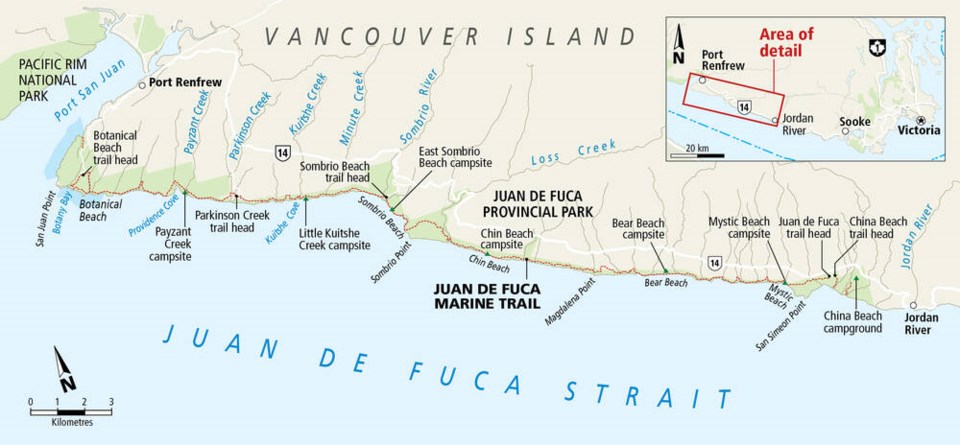Four large bridges, eight smaller spans and several sections of stairs and boardwalks have been replaced on the Juan de Fuca Marine Trail, giving hikers wide-open access after nearly a year of detours and section closures.
B.C. Parks spokeswoman Gina Bugslag said crews have completed much of the work over the past six months, including complicated cliff-ladder systems near Bear Beach campsite that were destroyed by a landslide that closed the section last October.
The majority of the repair work was done between Chin Beach and Mystic Beach campsites — the most difficult section of the trail, said Bugslag.
The 47-kilometre Juan de Fuca Trail runs from China Beach to Port Renfrew, following the old telegraph cable that connected Bamfield and Victoria in the late 1800s. It joined the provincial park system in 1995, with major trail infrastructure built using a legacy fund from the 1994 Victoria Commonwealth Games.
All of the infrastructure is coming to the end of its life at the same time, which posed challenges, Bugslag said.
Extreme wind and rain storms often topple trees and wash away sections of the trail, she said, especially in sections where steep ravines lead to the ocean and are prone to landslides. “It’s always an ongoing challenge to maintain the trail.”
B.C. Parks this year allocated $21.5 million over three years to expand outdoor recreation facilities across the province. The repairs on the Juan de Fuca cost $700,000 and were completed by two contracted crews. Helicopters were used to haul out old pieces of bridges and boardwalks, as well as carrying in wood for rebuilding.
Like the West Coast Trail, a 75-kilometre route from Bamfield to Port Renfrew, the Juan de Fuca can be wet and extremely muddy from start to finish — and it’s been very busy as the spring and summer hiking season starts.
Juan de Fuca Search and Rescue had crews out Thursday searching for two lost hikers after receiving a call overnight.
Kathryn Farr, deputy chief of the search and rescue operation, said no details were immediately available on the status of the search. She said calls for rescues will become more common as the hiking season gets underway.
“One month we might get four calls, the next it could be two,” she said.
“The trail is muddy, which is typical for the West Coast Trail and the Juan de Fuca Trail … even well into the summer.”
With no cell service in the area, Farr said hikers should get to the beach and call 911 through U.S. roaming services.
A trail-preparation video from AdventureSmart, promoted by B.C. Parks and Juan de Fuca Search and Rescue, said fallen trees and other natural detours off the trail can cause hikers “to easily become lost in the dense forest, even if only a few metres from the trail.”
Knowing the tide tables is also essential, as many parts of the trail are on the beach. High tides can push hikers into the forest where there are no trails, increasing the possibility of getting lost.
Hikers are advised to come prepared with good boots and gaiters, waterproof wear and extra food and water.
Bugslag said it’s also essential to prepare a trip plan, and let others know your schedule.
And be prepared for lots of tree roots and to “embrace the mud,” said Bugslag. “You just can’t avoid it.”
She said the Juan de Fuca is used by about 40,000 hikers each year based on registration in its backcountry camping program, though the number is likely much higher, with day users having road access to sections of the trail at several locations along the route.



